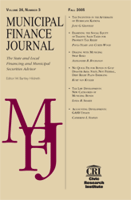Complete Issue
Author: Daniel Bergstresser.; W. Bartley Hildreth.
Source: Volume 35, Number 02, Summer 2014 , pp.1-82(82)

< previous article |return to table of contents
Abstract:
The three papers we have included in this special edition of Municipal Finance Journal were selected from presentations at the second annual Municipal Finance Conference in Boston, Massachusetts, held August 1 and 2, 2013 and hosted by the Brandeis International Business School and the “Bond Buyer.” The papers—on market segmentation, market reaction to pension problems, and the municipal tax exemption—are authored by research teams housed in the academic sphere, in the Federal Reserve System, and at a nonprofit institution. A paper by Robert Greer and Dwight Denison focuses on a particularly important question: the extent to which municipal markets in the United States are local as opposed to national. This question has important implications for the cost of capital to issuers in different parts of the country. The investigators use the fact that Texas municipal bond investors face no state income tax, and they show that Texas issuer bond yields appear to respond more to local supply than to national supply. This is is an important piece of evidence confirming the extent to which markets are segmented in the United States, even for reasons having nothing to do with state taxes. A paper by a team of researchers at the Federal Reserve Bank of Cleveland investigates the extent to which pension liabilities are priced into municipal bond yields. The authors present a result that is perhaps surprising in light of the recent focus on pensions in the popular press. They find that at the state level, the extent of pension underfunding has limited explanatory power for municipal yields. This result suggests that the financial markets may be taking a somewhat more sanguine view of pension liabilities than some of the commentators who have been focusing on public pension problems. A paper by a team of researchers from the Urban Institute and the Brookings Institution looks at the “incidence” of the municipal tax exemption. A key driver of the debate around the tax exemption has to do with the incidence of the tax exemption—in ot er words, what the real economic effect of this tax exemption is. It is a basic principal of taxation that the true bearer of the economic burden of a tax may be different from the person who actually writes the check. A payroll tax, for example, actually lands on the firms that pay wages if wages just go up by the full amount of the tax, leaving employment and after-tax wages the same as before. One of the nice contributions of this paper is to show how the view of incidence depends on specific assumptions about investor behavior. A “Comment” on the paper by an industry researcher expands the discussion. Animating all of this research on municipal markets, and driving the Conference that highlighted some of the papers in this rapidly growing research area, is an important underlying goal. We study municipal capital markets because they are essential to the functioning of our economy. Without infrastructure—schools, roads, ports, fire stations—our way of life would be impossible. The federal system of government, of which we are so justifiably proud, means that decisions about this infrastructure will often be made at the state and local level. This is a system that has worked well for generations. Improving our understanding of how the municipal capital markets function will, over the long run, lead the markets to function more efficiently. It will also help inform regulation in ways that support (rather than hinder) the development and operation of these capital markets. This research is important work, and the organizers of the Municipal Finance Conference have been proud to support and highlight it.Keywords: Preferred habitat, market segmentation, municipal bonds, visible supply, Municipal bond market, state funding costs, public pensions, Tax incidence. tax-exempt bonds, implicit taxes and subsidies, distributional analysis, microsimulation models, tax
Affiliations:
1: (Guest Editor) Brandeis International Business School; 2: Georgia State University.